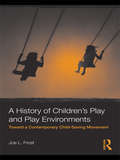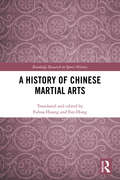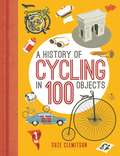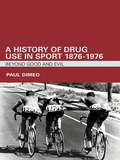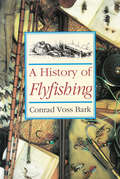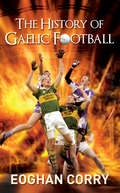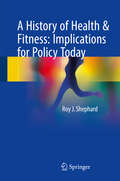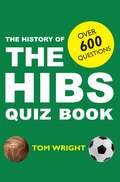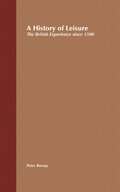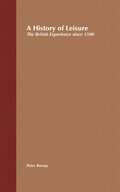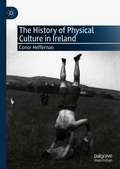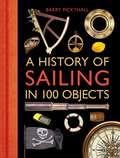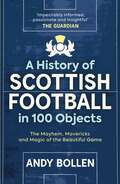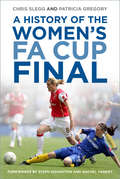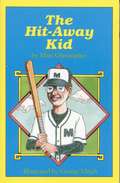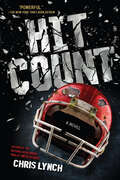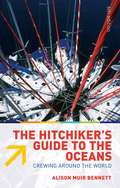- Table View
- List View
A History of Children's Play and Play Environments: Toward a Contemporary Child-Saving Movement
by Joe L. FrostChildren’s play throughout history has been free, spontaneous, and intertwined with work, set in the playgrounds of the fields, streams, and barnyards. Children in cities enjoyed similar forms of play but their playgrounds were the vacant lands and parks. Today, children have become increasingly inactive, abandoning traditional outdoor play for sedentary, indoor cyber play and poor diets. The consequences of play deprivation, the elimination and diminution of recess, and the abandonment of outdoor play are fundamental issues in a growing crisis that threatens the health, development, and welfare of children. This valuable book traces the history of children’s play and play environments from their roots in ancient Greece and Rome to the present time in the high stakes testing environment. Through this exploration, scholar Dr. Joe Frost shows how this history informs where we are today and why we need to re-establish play as a priority. Ultimately, the author proposes active solutions to play deprivation. This book is a must-read for scholars, researchers, and students in the fields of early childhood education and child development.
A History of Children's Play and Play Environments: Toward a Contemporary Child-Saving Movement
by Joe L. FrostChildren’s play throughout history has been free, spontaneous, and intertwined with work, set in the playgrounds of the fields, streams, and barnyards. Children in cities enjoyed similar forms of play but their playgrounds were the vacant lands and parks. Today, children have become increasingly inactive, abandoning traditional outdoor play for sedentary, indoor cyber play and poor diets. The consequences of play deprivation, the elimination and diminution of recess, and the abandonment of outdoor play are fundamental issues in a growing crisis that threatens the health, development, and welfare of children. This valuable book traces the history of children’s play and play environments from their roots in ancient Greece and Rome to the present time in the high stakes testing environment. Through this exploration, scholar Dr. Joe Frost shows how this history informs where we are today and why we need to re-establish play as a priority. Ultimately, the author proposes active solutions to play deprivation. This book is a must-read for scholars, researchers, and students in the fields of early childhood education and child development.
A History of Chinese Martial Arts (Routledge Research in Sports History)
by Fuhua Huang Fan HongChinese martial arts have a long, meaningful history and deep cultural roots. They blend the physical components of combat with strategy, philosophy and tradition, distinguishing them from Western sports. A History of Chinese Martial Arts is the most authoritative study ever written on this topic, featuring contributions from leading Chinese scholars and practitioners. The book provides a comprehensive overview of all types of Chinese martial arts, from the Pre-Qin Period (before 222 BC) right up to the present day in the People’s Republic of China, with each chapter covering a different period in Chinese history. Including numerous illustrations of artefacts, weaponry and historical drawings and documents, this book offers unparalleled insight into the origins, development and contemporary significance of martial arts in China. This is a fascinating read for researchers and students working in sports history, Chinese sport and Chinese Studies.
A History of Chinese Martial Arts (Routledge Research in Sports History)
Chinese martial arts have a long, meaningful history and deep cultural roots. They blend the physical components of combat with strategy, philosophy and tradition, distinguishing them from Western sports. A History of Chinese Martial Arts is the most authoritative study ever written on this topic, featuring contributions from leading Chinese scholars and practitioners. The book provides a comprehensive overview of all types of Chinese martial arts, from the Pre-Qin Period (before 222 BC) right up to the present day in the People’s Republic of China, with each chapter covering a different period in Chinese history. Including numerous illustrations of artefacts, weaponry and historical drawings and documents, this book offers unparalleled insight into the origins, development and contemporary significance of martial arts in China. This is a fascinating read for researchers and students working in sports history, Chinese sport and Chinese Studies.
A History of Cycling in 100 Objects
by Suze ClemitsonA fascinating and quirky look at the history of cycling as seen through 100 objects that changed the bicycle as we know it. From the laufmachine to the Brompton, learn about the evolution of the bicycle from two wheeled toy of the aristocracy through to the boom years of the cycling revolution today. Find out why newspapers are so integral to the story of cycling, why the yellow jersey is yellow and why steak was so important to keep a ride comfortable back in the day. Taking one hundred objects that have been pivotal in the development of cycling and the bikes themselves, this book provides a fascinating insight into the history of cycling. From the earliest prototype bikes through to the speed machines we know today, it also covers key technological developments and the more esoteric - from the Arc de Triomphe and liquorice allsorts via ballbearings and Shimano gears. Beautifully documented with lively and insightful text, this is the perfect gift for the cyclist in your life, giving an alternative insight into the two wheeled revolution.
A History of Cycling in 100 Objects
by Suze ClemitsonA fascinating and quirky look at the history of cycling as seen through 100 objects that changed the bicycle as we know it. From the laufmachine to the Brompton, learn about the evolution of the bicycle from two wheeled toy of the aristocracy through to the boom years of the cycling revolution today. Find out why newspapers are so integral to the story of cycling, why the yellow jersey is yellow and why steak was so important to keep a ride comfortable back in the day. Taking one hundred objects that have been pivotal in the development of cycling and the bikes themselves, this book provides a fascinating insight into the history of cycling. From the earliest prototype bikes through to the speed machines we know today, it also covers key technological developments and the more esoteric - from the Arc de Triomphe and liquorice allsorts via ballbearings and Shimano gears. Beautifully documented with lively and insightful text, this is the perfect gift for the cyclist in your life, giving an alternative insight into the two wheeled revolution.
A History of Drug Use in Sport: Beyond Good and Evil
by Paul DimeoThis book offers a new history of drug use in sport. It argues that the idea of taking drugs to enhance performance has not always been the crisis or ‘evil’ we now think it is. Instead, the late nineteenth century was a time of some experimentation and innovation largely unhindered by talk of cheating or health risks. By the interwar period, experiments had been modernised in the new laboratories of exercise physiologists. Still there was very little sense that this was contrary to the ethics or spirit of sport. Sports, drugs and science were closely linked for over half a century. The Second World War provided the impetus for both increased use of drugs and the emergence of an anti-doping response. By the end of the 1950s a new framework of ethics was being imposed on the drugs question that constructed doping in highly emotive terms as an ‘evil’. Alongside this emerged the science and procedural bureaucracy of testing. The years up to 1976 laid the foundations for four decades of anti-doping. This book offers a detailed and critical understanding of who was involved, what they were trying to achieve, why they set about this task and the context in which they worked. By doing so, it reconsiders the classic dichotomy of ‘good anti-doping’ up against ‘evil doping’. Winner of the 2007 Lord Aberdare Literary Prize for the best book in British sports history.
A History of Drug Use in Sport: Beyond Good and Evil
by Paul DimeoThis book offers a new history of drug use in sport. It argues that the idea of taking drugs to enhance performance has not always been the crisis or ‘evil’ we now think it is. Instead, the late nineteenth century was a time of some experimentation and innovation largely unhindered by talk of cheating or health risks. By the interwar period, experiments had been modernised in the new laboratories of exercise physiologists. Still there was very little sense that this was contrary to the ethics or spirit of sport. Sports, drugs and science were closely linked for over half a century. The Second World War provided the impetus for both increased use of drugs and the emergence of an anti-doping response. By the end of the 1950s a new framework of ethics was being imposed on the drugs question that constructed doping in highly emotive terms as an ‘evil’. Alongside this emerged the science and procedural bureaucracy of testing. The years up to 1976 laid the foundations for four decades of anti-doping. This book offers a detailed and critical understanding of who was involved, what they were trying to achieve, why they set about this task and the context in which they worked. By doing so, it reconsiders the classic dichotomy of ‘good anti-doping’ up against ‘evil doping’. Winner of the 2007 Lord Aberdare Literary Prize for the best book in British sports history.
A History of Flyfishing
by Conrad Voss BarkMan has been fishing for trout and salmon with the fly since the time of the Ancient Greeks. Devising ever more ingenious methods of doing so, his rods, reels, lines and flies have evolved in fascinating ways. With a delightful blend of wit and erudition, Conrad Voss Bark tells the story of flyfishing, from the Macedonian 'plumes' of old to the hairwing streamers of today. He spotlights the sport's formative protagonists - Juliana Berners, Robert Venables, Isaak Walton, Charles Cotton, Alfred Ronalds, George Kelson, J.C. Mottram, Dr Bell, and many others, using his journalist's skills to appraise the prevailing dogmas, the breakthroughs in tackle and to re-live the great debates and controversies, including the famous Skues-Halford dispute. Throughout, flyfishing is seen against the broader canvas of changing times in Britain, Ireland and North America. Today there are new forces which are shaping flyfishing history: water pollution, drift netting, over-kill, timeshare, catch-and-release and the explosion of new materials from which tackle and flies are made. Not since Waller Hills' classic History of Flyfishing for Trout of 1921, has a broad survey of this fascinating sport been tackled with such individual style and verve.
The History of Gaelic Football: The Definitive History of Gaelic Football from 1873
by Eoghan CorriganGaelic football has grown into a massive modern entertainment industry, celebrated on summer Sundays at Europe’s third largest sports stadium. Yet it has retained a unique relationship with the often small local communities which sustain it.Gaelic footballers and their followers receive no payment, have no transfer system and remain loyal to their home counties as players and supporters. This is more than a sport – it is a subculture of its own, with songs, stories and ceremonies that are unique in the sporting world. In this fascinating book, Eoghan Corry charts the emergence of great Gaelic football teams, players and rivalries whose tactics brought success and whose innovations changed the sport itself. The History of Gaelic Football also outlines how the game became entangled in the political life of Ireland, tracing its course as it weaved and bobbed through political controversy, civil war and Ireland’s rapidly-changing society over the course of the twentieth century. It recounts hilarious incidents from the history of Gaelic football, from invading crowds to crazy goals, detailing the rough, the tough and the bizarre that characterise the sport. Above all, it celebrates the players who bring entertainment, excitement and excellence, and who enrich the lives of ordinary people across Ireland and the world.The History of Gaelic Football: Table of Contents Author’s NoteIntroduction1873–1903: The Battle of the Balls 1903–27: A Popular Game 1927–47: Hand Across the Atlantic 1948–74: Strong and Forthright Men 1987–2000: Inside the Mind of the Champion More Matches, More Watchers
A History of Health & Fitness: Implications for Policy Today
by Roy J. ShephardThis book provides a unique and succinct account of the history of health and fitness, responding to the growing recognition of physicians, policy makers and the general public that exercise is the most potent form of medicine available to humankind. Individual chapters present information extending from the earliest reaches of human history to the present day, arranged in the form of 30 thematic essays covering topics from the supposed idyll of the hunter-gatherer lifestyle and its posited health benefits to the evolution of health professionals and the possible contribution of the Olympic movement to health and fitness in our current society. Learning objectives are set for each topic, and although technical language is avoided as far as possible, a thorough glossary explains any specialized terms that are introduced in each chapter. The critical thinking of the reader is stimulated by a range of questions arising from the text context, and each chapter concludes with a brief discussion of some of the more important implications for public policies on health and fitness today and into the future. The material will be of particular interest to graduate and undergraduate students in public health, health promotion, health policy, kinesiology, physical education, but will be of interest also to many studying medicine, history and sociology.
The History of Hibs Quiz Book
by Tom WrightThis quiz book covers the fascinating journey of Hibernian Football Club throughout the past 142 years. Offcial club historian Tom Wright has used his comprehensive knowledge of the sport and the team to devise over 600 questions spanning from the early days of the club to the present. This is the perfect book for fans of all ages to learn more about the history of one of Scotland’s greatest football teams.
A History of Leisure: The British Experience since 1500
by Peter BorsayLeisure is a key aspect of modern living. How did our ancestors experience recreation in the past, and how does this relate to the present? To answer these questions, Peter Borsay examines the history of leisure in Britain over the past 500 years, analysing elements of both continuity and change. A History of Leisure- explores a range of pastimes, from festive culture and music to tourism and sport- emphasises a conceptual and critical approach, rather than a simple narrative history- covers a range of themes including economy, state, class, identities, place, space and time- treats the constituent parts of the British Isles as a fluid and dynamic amalgam of local and national cultures and polities.Authoritative and engaging, this text challenges conventional views on the history of leisure and suggests new approaches to the subject. Borsay draws upon the insights provided by a variety of disciplines alongside that of history - anthropology, the arts, geography and sociology - to offer an essential guide to this fascinating area of study.
A History of Leisure: The British Experience since 1500
by Peter BorsayLeisure is a key aspect of modern living. How did our ancestors experience recreation in the past, and how does this relate to the present? To answer these questions, Peter Borsay examines the history of leisure in Britain over the past 500 years, analysing elements of both continuity and change.A History of Leisure- Explores a range of pastimes, from festive culture and music to tourism and sport- Emphasises a conceptual and critical approach, rather than a simple narrative history- Covers a range of themes including economy, state, class, identities, place, space and time- Treats the constituent parts of the British Isles as a fluid and dynamic amalgam of local and national cultures and politiesAuthoritative and engaging, this text challenges conventional views on the history of leisure and suggests new approaches to the subject. Borsay draws upon the insights provided by a variety of disciplines alongside that of history - anthropology, the arts, geography and sociology - to offer an essential guide to this fascinating area of study.
The History of Physical Culture in Ireland
by Conor HeffernanThis book is the first to deal with physical culture in an Irish context, covering educational, martial and recreational histories. Deemed by many to be a precursor to the modern interest in health and gym cultures, physical culture was a late nineteenth and early twentieth century interest in personal health which spanned national and transnational histories. It encompassed gymnasiums, homes, classrooms, depots and military barracks. Prior to this work, physical culture’s emergence in Ireland has not received thorough academic attention. Addressing issues of gender, childhood, nationalism, and commerce, this book is unique within an Irish context in studying an Irish manifestation of a global phenomenon. Tracing four decades of Irish history, the work also examines the influence of foreign fitness entrepreneurs in Ireland and contrasts them with their Irish counterparts.
A History of Sailing in 100 Objects
by Barry PickthallDid you ever wonder which civilisation first took to water in small craft? Who worked out how to measure distance or plot a course at sea? Or why the humble lemon rose to such prominence in the diets of sailors?Taking one hundred objects that have been pivotal in the development of sailing and sailing boats, the book provides a fascinating insight into the history of sailing. From the earliest small boats, through magnificent Viking warships, to the technology that powers some of the most sophisticated modern yachts, the book also covers key developments such as keeps and navigational aids such as the astrolabe, sextant and compass. Other more apparently esoteric objects from all around the world are also included, including the importance of citrus fruit in the prevention of scurvy, scrimshaw made from whalebone and the meaning of sailor's tattoos.Beautifully illustrated with lively and insightful text, it's a perfect gift for the real or armchair sailor, the book gives an alternative insight into how and why we sail the way we do today.
A History of Sailing in 100 Objects
by Barry PickthallDid you ever wonder which civilisation first took to water in small craft? Who worked out how to measure distance or plot a course at sea? Or why the humble lemon rose to such prominence in the diets of sailors?Taking one hundred objects that have been pivotal in the development of sailing and sailing boats, the book provides a fascinating insight into the history of sailing. From the earliest small boats, through magnificent Viking warships, to the technology that powers some of the most sophisticated modern yachts, the book also covers key developments such as keeps and navigational aids such as the astrolabe, sextant and compass. Other more apparently esoteric objects from all around the world are also included, including the importance of citrus fruit in the prevention of scurvy, scrimshaw made from whalebone and the meaning of sailor's tattoos.Beautifully illustrated with lively and insightful text, it's a perfect gift for the real or armchair sailor, the book gives an alternative insight into how and why we sail the way we do today.
A History of Scottish Football in 100 Objects: The Alternative Football Museum
by Andy BollenAndy Bollen has created a fantasy football museum to collect together a treasure trove of Scottish football exhibits that ranges from Jimmy Johnstone’s oar to Aggie the tea lady's trolley. Learn why Puskas and Socrates should’ve been Scottish, the versatility of the pie and Napoleon’s links to Bovril and explore all the wonders of the game north of the Border - from Arthur Montford to the phone-in, Think Tanks, Buckfast, vanishing cream for referees, Twitter, VAR technology and flares (pyrotechnics, not 1970s attire). These exhibits distill the beauty of Scottish football into an entertaining volume that will make the perfect gift for any fan. Taking a satirical swipe at the beautifully flawed game, A History of Scottish Football in 100 Objects covers the mayhem, mavericks and bric-a-brac from the magic sponge, to the pie, hair weaves to tattoos. Bollen is the perfect curator: impeccably informed, passionate and insightful.
A History of Sports Coaching in Britain: Overcoming Amateurism (Routledge Research in Sports Coaching)
by Dave Day Tegan CarpenterAt the London Olympics in 2012 Team GB achieved a third place finish in the medals table. A key factor in this achievement was the high standard of contemporary British sports coaching. But how has British sports coaching transitioned from the amateur to the professional, and what can the hitherto under-explored history of sports coaching in Britain tell us about both the early history of sport and about contemporary coaching practice? A History of Sports Coaching in Britain is the first book to attempt to examine the history of British sports coaching, from its amateur roots in the deep nineteenth century to the high performance, high status professional coaching cultures of today. The book draws on original primary source material, including the lost coaching lives of key individuals in British coaching, to trace the development of coaching in Britain. It assesses the continuing impact of the nineteenth-century amateur ethos throughout the twentieth century, and includes important comparisons with developments in international coaching, particularly in North America and the Eastern Bloc. The book also explores the politicisation of sport and the complicated interplay between politics and coaching practice, and illuminates the origins of the structures, organisations and philosophies that surround performance sport in Britain today. This book is fascinating reading for anybody with an interest in the history of sport, sports coaching, sports development, or the relationships between sport and wider society.
A History of Sports Coaching in Britain: Overcoming Amateurism (Routledge Research in Sports Coaching)
by Dave Day Tegan CarpenterAt the London Olympics in 2012 Team GB achieved a third place finish in the medals table. A key factor in this achievement was the high standard of contemporary British sports coaching. But how has British sports coaching transitioned from the amateur to the professional, and what can the hitherto under-explored history of sports coaching in Britain tell us about both the early history of sport and about contemporary coaching practice? A History of Sports Coaching in Britain is the first book to attempt to examine the history of British sports coaching, from its amateur roots in the deep nineteenth century to the high performance, high status professional coaching cultures of today. The book draws on original primary source material, including the lost coaching lives of key individuals in British coaching, to trace the development of coaching in Britain. It assesses the continuing impact of the nineteenth-century amateur ethos throughout the twentieth century, and includes important comparisons with developments in international coaching, particularly in North America and the Eastern Bloc. The book also explores the politicisation of sport and the complicated interplay between politics and coaching practice, and illuminates the origins of the structures, organisations and philosophies that surround performance sport in Britain today. This book is fascinating reading for anybody with an interest in the history of sport, sports coaching, sports development, or the relationships between sport and wider society.
A History of the Women's FA Cup Final
by Chris Slegg Patricia GregoryA History of the Women’s FA Cup Final is an exhaustive account of fifty finals, from the first (on a bumpy field inside an athletics stadium) to the fiftieth (at Wembley, televised to millions), complete with match reports and interviews with some of the greatest players ever to grace the pitch. Every women’s FA Cup Final goal scorer can be confirmed in one place for the first time, and the achievements of previously unknown record holders can at last be fully recognised. But this is more than just a stats book; it is a tribute to the pioneers of the game, who fought to overturn a fifty-year ban on female players and who paved the way for the incredible game we have today.
The History of the World Rugby Cup
by Peter Murray Lorri LynnThe Rugby World Cup is contested every four years between the top international teams. The tournament was first held in 1987, when the tournament was co-hosted by New Zealand and Australia. The winners are awarded the Webb Ellis Cup, named after William Webb Ellis, the Rugby School pupil who, according to a popular legend, invented rugby by picking up the ball during a football game. Four countries have won the trophy; New Zealand three times, Australia and South Africa each twice, and England once. New Zealand are the current champions, having defeated Australia in the final of the 2015 tournament in England. Japan will host the 2019 Rugby World Cup and France will host in 2023. This book is a collector’s edition featuring images and details from every World Cup since 1975: a must for every Rugby fan.
The Hit-Away Kid (Peach Street Mudders)
by Matt ChristopherBarry McGee, hit-away batter for the Peach Street Mudders, enjoys winning so much that he has a tendency to bend the rules; then the dirty tactics of the pitcher on a rival team give him a new perspective on sports ethics.
Hit Count
by Chris LynchAcclaimed author Chris Lynch explores the American love affair with football and our attempts to come to terms with the dangers of the sport through Arlo Brodie, a teen who loves being at the heart of the action on the football field, getting hit hard and hitting back harder.
The Hitchiker's Guide to the Oceans: Crewing Around the World
by Alison Muir BennettWhat better way of travelling the world than by crewing on a yacht? The Hitchiker's Guide to the Oceans is ideal for crew pre-planning, and for skippers seeking crew. It is packed with practical information from how to find a crew position, what to expect from different kinds of skipper, how to be in the right place at the right time, where the yachts gather and when, to rally locations, how to maximise your chances of being taken on as crew, what will be expected of you as crew, and job opportunities along the way. Unique yacht migration maps show where the seasonal bottlenecks occur, and help pinpoint the best places and times of year to gain a crew place. This sixth edition with fully updated information and website addresses as well as a new colour section will be welcomed by all aspiring yacht crew, and also as a skipper's reference. 'Packed with all the information you'd need to find a crewing position... an invaluable guide to crewing anywhere in the world.' Yachting Monthly'Valuable for the first-timer and useful for skippers and their potential crew.' Classic Boat
